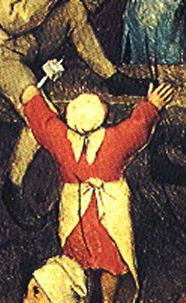 | ||
A teetotum (or T-totum) is a form of gambling spinning top that is known across Europe from Roman times. It has a polygonal body - originally four-sided - marked with letters or numbers, which indicate the result of each spin. The name originates from Latin Totum meaning 'all' which was marked by a T on one of the four sides and indicated that the winning player could take all the played tokens.
Contents
Description
In its earliest form the body was square (in some cases via a stick through a regular six-sided die ), marked on the four sides by the letters A (Lat. aufer, take) indicating that the player takes one from the pool, D (Lat. depone, put down) when a fine has to be paid, N (Lat. nihil, nothing), and T (Lat. totum, all), when the whole pool is to be taken.
Other accounts give such letters as P, N, D (dimidium, half), and H or T or other combinations of letters. Other combinations of letters that could be found were NG, ZS, TA, TG, NH, ND, SL and M, which included the Latin terms Zona Salve ("save all"), Tibi Adfer ("take all"), Nihil Habeas ("nothing left"), Solve L ("save 50") and Nihil Dabis ("nothing happens"),
Joseph Strutt, who was born in 1749, mentions the teetotum as used in games when he was a boy:
When I was a boy, the tee-totum had only four sides, each of them marked with a letter; a T for take all; an H for half, that is of the stake; an N for nothing; and a P for put down, that is, a stake equal to that you put down at first. Toys of this kind are now made with many sides and letters.
The teetotum survives today as dreidel, a Jewish game played on Hanukkah and as the Perinola, a game played in many Latin American countries. Some modern teetotums have six or eight sides, and are used in commercial board games in place of dice. The original 1860 version of The Game of Life used a teetotum in order to avoid the die's association with gambling.
Teetotum in literature
A teetotum is mentioned by "Martinus Scriblerus", the pen name of a club of 18th-century satirical writers.
The 19th-century English poet William Ernest Henley wrote the Double Ballade on the Nothingness of Things which opened with the lines:
In Lewis Carroll's fantasy Through the Looking-Glass, Alice's movements about the Old Sheep Shop provoke its proprietor (the White Queen transformed into a sheep) to ask, "Are you a child, or a teetotum?"
In Edgar Allan Poe's 1845 dark comedy short story "The System of Doctor Tarr and Professor Fether", one of the patients of the asylum is described as believing he had been converted into a "tee-totum":
"And then," said the friend who had whispered, "there was Boullard, the tee-totum. I call him the tee-totum because, in fact, he was seized with the droll but not altogether irrational crotchet, that he had been converted into a tee-totum. You would have roared with laughter to see him spin. He would turn round upon one heel by the hour, in this manner -- so-
Here the friend whom he had just interrupted by a whisper, performed an exactly similar office for himself.
